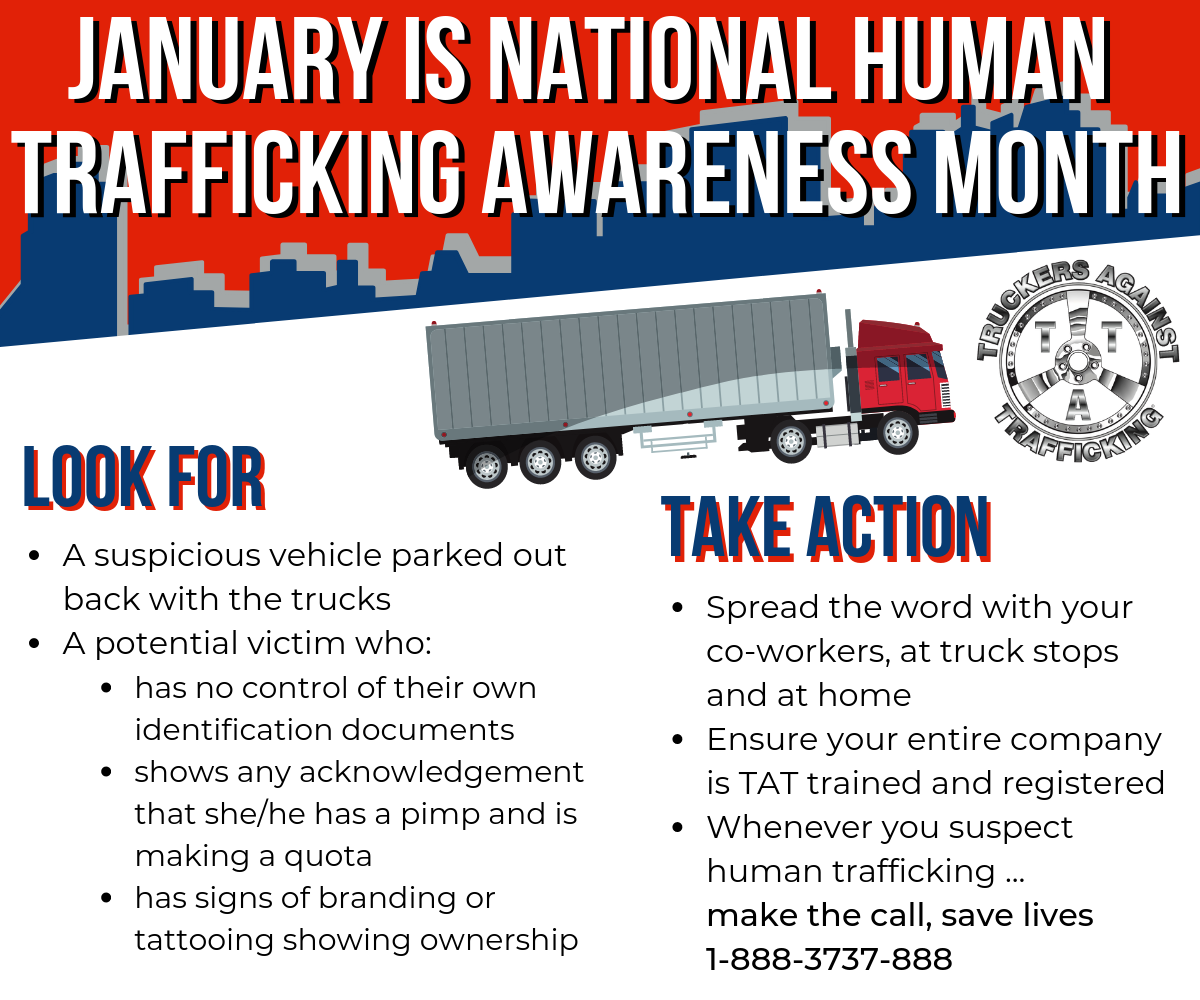Ruan is a proud sponsor of Truckers Against Trafficking.
By Lyn Leeburg, TAT Communications Director and Co-Founder
When working on a strategy to fight human trafficking, one of the first steps should be to determine
which groups of people have the greatest opportunity to spot human trafficking as it is happening. In
other words, who could serve as the primary surveillance?

When it comes to this crime, those front-line people include such groups as medical personnel, who treat victims in medical clinics; service personnel in local neighborhoods (such as postal workers, and cable, electrical, and water providers), who come by homes on a regular basis and would notice if something unusual was going on; restaurant and hotel personnel, who might see trafficking taking place in their establishments; and members of all segments of the transportation industry, including airport employees, because traffickers are continually transporting victims to sell them in a variety of places.
Truckers Against Trafficking (TAT) began as an initiative of Chapter 61 Ministries in 2009 to work with the trucking industry, because it’s 7-million strong. Truckers are trained to be extremely observant. The trucking industry is composed of people already entrusted with caring for other people’s goods, which speaks to the character of the industry when it comes to caring for others—especially when the interest of others might be in trouble. Members of the trucking industry are everywhere, covering the entire United States. Lastly, traffickers wanting to make fast money often target truckers at truck stops and rest areas (because they’re everywhere and easy to reach right along highways) to sell their victims. This is evidenced by the number of victims rescued from truck stops by the FBI.
The members of Chapter 61 Ministries believed that if the trucking industry were empowered with education and equipped with tools to fight human trafficking, they would be quick to mobilize against this crime. They could do their part to see victims recovered and perpetrators arrested. Members of the trucking industry could be everyday heroes in the course of their jobs and make a significant impact against the criminal activity of human trafficking. Perhaps they might even have a greater impact than the average person, because of their mobility and training. They were a critical front-line group to recruit.

Using tools such as an informational website (www.TruckersAgainstTrafficking.org), on-demand webinars, a trucking-industry-specific training DVD, wallet cards with signs to look for and questions to ask, and social media accounts, TAT began making contacts throughout the trucking industry to build relationships and state the case for trucking members to join the abolitionist
movement. TAT also began having a presence at major trucking shows as well as providing free presentations wherever requested by members of the trucking industry. The trucking industry began responding positively. By 2011, TAT had grown so much and was making such an impact in the industry that it needed to become an independent 501(c)3 non-profit organization in order to sustain its efforts.
Members of the trucking industry, who had witnessed the prostitution of women and minors at various places throughout the United States for years but who had not known what it was – forced prostitution and modern-day slavery – began calling the National Human Trafficking Hotline to report what they were seeing. Since Dec. 7th, 2007, when the hotline began, the national hotline has received 2,692+ calls from truckers, which have opened 708 likely cases of human trafficking involving 1,296 people. Major travel plaza and truck stop organizations joined TAT by making a commitment to train their employees with TAT materials and to make those materials available for trucking customers across the United States. Truck-driving schools, national and state trucking organizations, trucking companies – both large and small – individual truckers, trucking organizations of all types, and trucking media have also joined forces with TAT.
TAT works to create relationships between state and federal law enforcement and members of the trucking industry through half-day events called coalition builds. These events provide a more effective localized response to human trafficking by gathering law enforcement agencies (state, federal, and local) and local anti-trafficking resources (task forces and local non-governmental organizations) in the same room with key industry stakeholders, including general managers of truck stops and representatives of state trucking associations and carriers.
Using TAT materials, the Motor Vehicle Enforcement division of the Iowa Department of Transportation has created a model for other states to follow in working with the trucking industry. They place TAT materials in their state scale sites, state rest areas, and state truck stops. They are also working with major carriers in the state to train their employees with TAT materials.
Why truckers? Watching the TAT training DVD readily answers that question. With one phone call, a trucker who saw some under-aged girls working a truck stop not only facilitated the recovery of those girls, but also that of seven other minors. Thirty-one offenders were arrested, and a 13-state prostitution ring was broken.
Training and working with front-line responders in the United States in the fight against human trafficking is a strategy that can and does yield big results … and members of the trucking industry are some of the leading front-line responders.
Click to learn more about Truckers Against Trafficking.